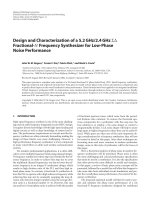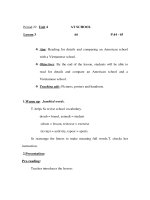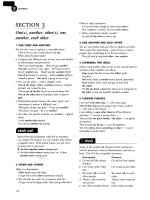Antenna design for 2 4 GHz ISM band
Bạn đang xem bản rút gọn của tài liệu. Xem và tải ngay bản đầy đủ của tài liệu tại đây (1.6 MB, 130 trang )
ANTENNA DESIGN FOR 2.4 GHz ISM BAND
LU LU
NATIONAL UNIVERSITY OF SINGAPORE
2006
ANTENNA DESIGN FOR 2.4 GHz ISM BAND
LU LU
(B.ENG, NATIONAL UNIVERSITY OF SINGAPORE)
A THESIS SUBMITTED
FOR THE DEGREE OF MASTER OF ENGINEERING
DEPARTMENT OF ELECTRICAL AND COMPUTER
ENGINEERING
NATIONAL UNIVERSITY OF SINGAPORE
2006
Acknowledgements
Firstly, I would like to take this opportunity to express my deepest
gratefulness to my supervisor Prof. J.C. Coetzee (NUS) for his time, help and
support for completion of this project.
I would also like to extend my gratitude to my colleagues in the Microwave
research group, Chua Ping Tyng, Lu Yihao, Ng Tiong Huat, for many enjoyable
hours of discussions and working.
Last, I would like to give special thanks to Mr. Teo Tham Chai, Mdm. Lee
Siew Choo, Mr. Sing Cheng Hiong, Mr. Hui So Chi and Mdm. Guo Lin for their
greatest support in sharing their knowledge and effort in my fabrication and
measurement processes.
i
Table of Contents
Acknowledgements.............................................................................................i
List of Figures.....................................................................................................v
List of Tables..................................................................................................... x
List of Symbols and Abbreviations…................................................................ xi
Abstract..............................................................................................................1
Chapter 1 Introduction……….............................................................................3
1.1. Background..............................................................................................3
1.2. Aims……………………............................................................................5
1.3. Contribution…………...............................................................................6
1.4. Outline……..............................................................................................7
Chapter 2 Antenna design fundamentals...........................................................8
2.1. Introduction……………............................................................................8
2.2. Basic definition of antenna.......................................................................8
2.2.1. Impedance bandwidth..................................................................8
2.2.2. Radiation pattern......................................................................... 9
2.2.3. Gain...........................................................................................10
2.3. Compact design basics..........................................................................10
2.4. Circularly polarization design.................................................................14
2.5. Finite-difference time-domain analysis……...........................................16
2.6. Summary………………..........................................................................22
Chapter 3 Reduced size antenna design……………........................................23
ii
3.1. Introduction............................................................................................23
3.2. Antenna design......................................................................................27
3.2.1. Theoretical design..................................................................... 27
3.2.2. Full wave simulation.................................................................. 28
3.2.2.1. FEKO................................................................................28
3.2.2.2. HFSS................................................................................29
3.3. Experimental results and discussion..................................................... 30
3.3.1. Design procedures……………………...………………………….30
3.3.1.1 Testbed selection…………………………….………………31
3.3.1.2 Design guidelines…………………………………………….35
3.3.2 Measurement Results................................................................ 46
3.4. Summary ...............................................................................................49
Chapter 4 Planar monopole antenna design....................................................50
4.1. Introduction............................................................................................50
4.2. Literature review ...................................................................................51
4.2.1. Inverted L antenna………………………………………………....51
4.2.2. Dual mode inverted L antenna…………………………………….54
4.2.3. Inverted F antenna………………………………...……………….55
4.2.4. Dual band inverted F antenna…………………………………….56
4.2.5. Dual band inverted F antenna with an air gap………...…………57
4.2.6. Inverted L antenna with parasitic stripline…………………….….58
4.3. Antenna design .....................................................................................59
iii
4.3.1. Modified inverted L antenna with parasitic stripline (LU
antenna)……………………...………………….…………………59
4.3.2. Wideband monopole antenna……………….…………………….68
4.4. Summary……………………...................................................................72
Chapter 5 Circularly polarized antenna in Bluetooth BER measurement……..74
5.1. Introduction............................................................................................74
5.1.1. Enhancement techniques……………………………..…………..75
5.1.2. Circularly polarized waves and antennas……………..…………77
5.2. Antenna design......................................................................................78
5.3. BER measurement………......................................................................83
5.3.1. CASIRA Bluetooth module testing…………………...………….. 83
5.3.2. Test results............................................................................... 85
5.3. Summary…………………......................................................................85
Chapter 6 Conclusions……..............................................................................90
6.1. Conclusions...........................................................................................90
6.2. Future Works…………...........................................................................91
References………….........................................................................................93
Appendix C code for FDTD return loss simulation of the dual-band planar
monopole antenna…………...........................................................100
iv
List of Figures
Figure 2.1
Illustration of impedance bandwidth against frequency…….....9
Figure 2.2
Illustration of slots cut onto the non-radiating edges of the
metal patch.............................................................................12
Figure 2.3
Illustration of patch antenna with a shorting pin......................13
Figure 2.4
Illustration of LHCP and RHCP wave propagation.................15
Figure 2.5(a)
CP antenna with corner trimmed off a square patch…….…..15
Figure 2.5(b)
CP antennas with slot inserted in the diagonal direction of a
patch.......................................................................................16
Figure 2.6
Geometry of Yee’s cell used in FDTD analysis………..……...19
Figure 3.1
Geometrical structure of a conventional probe-fed microstrip
antenna…………………………………………………………...23
Figure 3.2
Illustration of probe-fed patch antenna with an air gap……....25
Figure 3.3
Geometrical structure of proposed double layer microstrip
patch antenna………………………..……………..…………....25
Figure 3.4
Impedance bandwidth against frequency for two identical
microstrip-fed antennas..........................................................31
Figure 3.5
Side view of the coaxial-fed model…………………………...32
Figure 3.6
Bottom view of the microstrip-fed ground layer……..………...32
Figure 3.7
Bottom view of the CBCPW-fed ground layer………..…….....32
Figure 3.8
Impedance bandwidth against frequency for different feeding
structures................................................................................33
v
Figure 3.9
Illustration of the SMA connector soldered onto the ground
layer……………………………………………………..……....34
Figure 3.10
Illustration of the testbed for the coupling examination……....34
Figure 3.11
Impedance bandwidth against frequency for different antenna
directions................................................................................35
Figure 3.12
Impedance bandwidth versus frequency for different patch
substrate length......................................................................36
Figure 3.13
Impedance bandwidth versus frequency for different patch
width.......................................................................................37
Figure 3.14(a) Impedance bandwidth versus frequency for different patch
Figure 3.14(b) substrate materials………………….………………………......38
Figure 3.15
Impedance bandwidth versus frequency for different patch
substrate thickness.................................................................39
Figure 3.16
Impedance bandwidth versus frequency for different patch
substrate length………………..…………………………….......40
Figure 3.17
Impedance bandwidth versus frequency for different patch
substrate width.......................................................................41
Figure 3.18
Impedance bandwidth versus frequency for different ground
plane sizes…………………..…………………………………...42
Figure 3.19
Illustration of the testbed for air gap height variation..............43
Figure 3.20
Impedance bandwidth against frequency for different metal
piece height…………………..…………………….………….....43
vi
Figure 3.21
Illustration of the testbed for connector metal shielding
variation…………………………………....……………………..44
Figure 3.22
Impedance bandwidth against frequency for different
connector metal shielding height............................................44
Figure 3.23
Illustration of the testbed for center metal shielding
variation…..............................................................................45
Figure 3.24
Impedance bandwidth against frequency for different center
metal shielding height………………..……………………….....46
Figure 3.25
Impedance bandwidth against frequency……..……..……......47
Figure 3.26
Measured antenna gain against frequency............................48
Figure 3.27
Measured radiation pattern.....................................................48
Figure 4.1
Microstrip-fed inverted L antenna………..………….………....52
Figure 4.2
Impedance bandwidth against frequency for microstrip feed
inverted L antenna..................................................................53
Figure 4.3
CPW/CBCPW-fed inverted L antenna………..………..……...53
Figure 4.4
Meander line planar dual band inverted L antenna………......54
Figure 4.5
Planar inverted F antenna......................................................55
Figure 4.6
Impedance bandwidth against frequency for microstrip feed
inverted F antenna..................................................................56
Figure 4.7
Dual band inverted F antenna................................................57
Figure 4.8
Dual band planar Inverted F with capacitive gap………..…....58
Figure 4.9
Inverted L with a parasitic L shape line...................................59
vii
Figure 4.10
Microstrip-fed inverted LU antenna…………..…………..…....60
Figure 4.11
Illustration of Gaussian pulse excitation…………..………......61
Figure 4.12
Impedance bandwidth against frequency for microstrip-fed
inverted LU antenna...............................................................64
Figure 4.13(a) Surface current of microstrip-fed inverted LU antenna at 2.45
GHz…………………………....................................................64
Figure 4.13(b) Surface current of microstrip-fed inverted LU antenna at 5.3
GHz…………………………....................................................65
Figure 4.14
Measured radiation pattern in three orthogonal x-y, x-z and y-z
planes at 2.45 and 5.3 GHz....................................................65
Figure 4.15
(CB) CPW-fed inverted LU antenna.......................................66
Figure 4.16(a) Impedance bandwidth against frequency for CPW-fed inverted
LU antenna……………………..……………….……………......67
Figure 4.16(b) Impedance bandwidth against frequency for CBCPW-fed
inverted LU antenna………………………………………...…...67
Figure 4.17
Wideband planar monopole antenna with coupled parasitic
lines…………………………………………………………….....69
Figure 4.18
Impedance bandwidth against frequency for wideband
monopole antenna.................................................................70
Figure 4.19(a) Surface current of Wideband planar monopole antenna with
coupled parasitic lines at 4 GHz.............................................70
viii
Figure 4.19(b) Surface current of Wideband planar monopole antenna with
coupled parasitic lines at 6 GHz.............................................71
Figure 4.19(c) Surface current of Wideband planar monopole antenna with
coupled parasitic lines at 8 GHz.............................................71
Figure 4.20
Measured radiation pattern in three orthogonal x-y, x-z, y-z
planes at 4, 6 and 8 GHz………..…………………….………...72
Figure 5.1
Illustration of space diversity set up........................................75
Figure 5.2
Illustraion of antenna diversity set up.....................................76
Figure 5.3
Geometry of the rectangular hole antenna design……..….....80
Figure 5.4
Impedence bandwidth against for rectangular hole antenna...81
Figure 5.5
Measured E field at E and H-plane…………...……………......82
Figure 5.6
Measured radiation pattern at E and H-plane………..….…....82
Figure 5.7
Illustration of BER test bed set up...........................................83
ix
List of Tables
Table 3.1 Physical dimensions of reduced-size microstrip antenna (Unit:
mm)…………………………………………………………………….46
Table 4.1 Physical dimensions of inverted L antenna (Unit: mm)…………....52
Table 4.2 Physical dimensions of inverted F antenna (Unit: mm)…………....55
Table 4.3 Physical dimensions of inverted LU antenna with parasitic stripline
(Unit: mm)……………………………………..………………..……....63
Table 4.4 Antenna gain at different frequencies…………………......…….......63
Table 4.5 Physical dimensions of dual band inverted L antenna (Unit:
mm)…………………………………..…………………….………......68
Table 4.6 Antenna gain at different frequencies…………………......…….......69
Table 5.1 Physical dimensions of rectangular hole antenna (Unit: mm)…..…80
Table 5.2 Measured BER w/o WLAN traffic....................................................85
Table 5.3 Measured BER from SCO link........................................................86
Table 5.4 Measured BER from ACL link.........................................................86
Table 5.5 Measured BER from light and heavy WLAN traffic…………….......87
Table 5.6 Measured BER w/o blockage…………………………...…..……......87
Table 5.7 Measured BER with a short Bluetooth transmission path………….88
x
List of Symbols and Abbreviations
BER
Bit Error Rate
CBCPW
Conductor Backed Coplanar Waveguide
CP
Circularly Polarized
CPW
Coplanar Waveguide
DOE
Design of Experiments
DSSS
Direct Sequence Spread Spectrum
EBG
Electrical Band Gap
EM
Electromagnetic
FDTD
Finite Difference Time Domain
FEC
Forward Error Correction
GSM
Global System for Mobiles
IC
Integrated Circuit
IEEE
Institute of Electrical and Electronics Engineers
ISI
Inter Symbol Interference
ISM
Industrial Scientific Medical
LHCP
Left Hand Circular Polarized
LOS
Line-Of-Sight
PDA
Personal Digital Assistant
RHCP
Right Hand Circular Polarized
RF
Radio Frequency
RMS
Root Mean Square
xi
TE
Transverse Electric
TM
Transverse Magnetic
UMTS
Universal Mobile Telecommunications System
VSWR
Voltage Standing Wave Ratio
WLAN
Wireless Local Area Network
WPAN
Wireless Personal Area Network
xii
Abstract
The utilization of 2.4 GHz ISM band has experienced enormous growth in
the last 5 years. A lot of research has been conducted on the design of
antennas operating inside this band. The limited space on the circuit board for
the RF module imposes a limit on the physical size available for the antenna.
This thesis presents two types of antennas to explore possible ways to solving
this problem: reduced antenna size and multiple operating frequency band
antennas.
A novel reduced size antenna which can easily be implemented has been
designed and shows promising results. This thesis gives the theoretical and
experimental results and provides a guideline for the design of such an antenna.
This antenna is fed by a pair of MCX connectors which is commercially
available and small in size. (MCX connector is one type of sub-miniature
connectors. It is possibly because these connectors are one of the few small
connectors that can be used inside PCs.) Different feeding mechanisms are
explored and the effects on antenna performance are shown.
A range of planar monopole antennas are also presented in this thesis.
Prototype antennas have been fabricated on the FR4 substrate with thickness
of 0.8 mm. Simulated and measured results of the impedance properties are
presented. Based on these designs, a new dual-band planar monopole
antenna is proposed. It is designed to work in both 2.4 GHz ISM band and 5.3
GHz band. The size of the ground is purposely chosen to be same as a WLAN
1
(Wireless Local Area Network) adapter card size. FDTD (Finite Difference Time
Domain) is used in the antenna impedance prediction. Results from
measurement, FDTD and FEM-based commercial results are presented. The
thesis also explores a possible way to further increase the impedance
bandwidth. Another prototype antenna was fabricated. The measured
impedance bandwidth covers frequency band from 3.22 GHz to 11.62 GHz. It
produces a radiation pattern which remains relatively stable at different
frequencies.
This work does not only consider the antenna design parameters from a
microwave perspective, but also focuses on the communication point of view. A
CASIRA Bluetooth development module was used to measure the BER (Bit
Error Rate) using the different antenna designs mentioned above together with
the RF module of the development kit. The measurement results presented are
used to determine whether the proposed antennas are suitable for the
Bluetooth applications. Furthermore, a way of mitigating the coexistence
interference in the 2.4 GHz ISM is proposed in this thesis. A circularly polarized
antenna was designed and BER measurements were performed. These results
are compared to those obtained with a linearly polarized antenna. It is found
that Bluetooth communication using a circularly polarized antenna has better
BER results when no counter-interference methods have been employed. The
circularly polarized antenna also shows better performance when there is no
line of sight transmission path in the Bluetooth channel.
2
Chapter 1
Introduction
1.1 Background
The proliferation of mobile computing devices including laptops, personal
digital assistants (PDAs) and wearable computers has created a greater
demand
for
wireless
personal
area
networks
(WPANs).
Wireless
communications based on Bluetooth and IEEE 802.1x are experiencing rapid
growth.
With the emergence of new materials and IC design techniques, mobile
units are also becoming more and more integrated. The miniaturization of the
wireless communication terminals has led to a requirement for antennas to be
small and lightweight. The technological progress which has produced
significant advances in the miniaturization of components and circuitry has not
been mirrored by corresponding advancements in antenna miniaturization.
Solid state components are now approaching structure sizes that are within a
fraction of a nanometer. Physical dimensions of most antennas are still of the
order of the wavelength of operation, such as half or quarter wavelength in
length. Conventional size reducing techniques include:
1) Usage of high dielectric constant material [1]
2) Introduction of slots onto the radiation patch and ground [1],[2]
3) Introduction of EBG (Electrical Band Gap) in the radiating patch or feed
line [3],[4]
3
4) Usage of passive circuit components [5]
Many attempts have been made to decrease the size of antennas using
these techniques. The theoretical and empirical results indicate that antenna
size reduction is often achieved at the expense of antenna gain and impedance
bandwidth. It is necessary to develop new size reducing techniques which have
little effect on the antenna performance.
In addition to the compact size requirement, it has also become necessary
to have a microstrip antenna that can be integrated with other devices while
supporting multiple frequency band operation. Planar monopole antennas have
attractive features of low profile, small size, conformability to mounting hosts
and wide impedance bandwidth [6]. With the coupling of line sections to the
main radiating patch, antennas can be designed to have dual band
performance or very wide bandwidth to fulfill this requirement.
Signal interference due to the collocation of the devices in the same
environment or RF functional blocks on the same circuit board have been
reported. The interference between Bluetooth and IEEE 802.11b WLAN is one
example.
Investigations
have
been
carried
out
to
study
Bluetooth
communication in an IEEE 802.11b WLAN environment and IEEE802.11b
WLAN in the Bluetooth communication environment [7]-[9]. Bluetooth
performance in coexistence with IEEE 802.11b depends on the length of the
Bluetooth link, the distance to the IEEE 802.11b interferer, the orientation of the
antennas, and the IEEE 802.11b activity [7]. Enhancement of the Bluetooth
4
performance in the IEEE802.11b communication can be achieved from [8]:
1) Adaptive frequency hopping for Bluetooth
2) Collaborative channel access schemes
3) Using different antenna orientations
Changing antenna orientation can be achieved from switched polarization
of antennas or simply using a pair of circularly polarized antennas [10]. With a
commercially available Bluetooth development device such as the CASIRA
Bluetooth development kit [11], the actual enhancement effects from using
different antenna polarizations can be measured by observing the BER (Bit
Error Rate).
1.2 Aims
The aim of this thesis is to address the issues raised in Section 1.1 in the
following ways:
z
Develop a design procedure for a reduced-size microstrip antenna
z
Investigate and possibly improve the current planar monopole
microstrip antenna design
z
Implement a circularly polarized microstrip antenna and investigate the
actual advantages of using it in a practical wireless communication
interference
A frequency of 2.4 GHz is chosen as the main design frequency. This
choice is based on the fact that both Bluetooth and IEEE 802.11b WLAN
5
operate in the 2.4 GHz ISM frequency band, and the available test bed is a
Bluetooth communication system.
1.3 Contributions
Various successful antenna designs were achieved in the course of this
research work. These include a reduced-size multilayer antenna, a dual-band
microstrip antenna and a wideband monopole antenna. A testbed with the
ability of measuring the Bluetooth communication quality was set up and
measurement results from circularly polarized antenna was obtained. The
possible advantages of using circular polarization to counter interference in
Bluetooth communication systems were quantified.
Original contributions of this thesis resulted in the following publications:
Journal papers
1. L. Lu and J. C. Coetzee, “Characteristics of a two layer microstrip patch
antenna for bluetooth applications”, Microwave and Optical Tech. Lett, vol.
48, pp. 683-686, 2006.
2. L. Lu and J.C. Coetzee, “A reduced size microstrip antenna for Bluetooth
applications”, Electronics Lett., vol. 41, pp.13-14, 2005.
3. L. Lu and J.C. Coetzee, “A modified dual band microstrip monopole
antenna”, accepted for publication in Microwave and Opt. Tech. Lett, 2006.
4. L. Lu and J.C. Coetzee, “A wideband planar monopole microstrip antenna
with coupled parasitic lines”, accepted for publication in Microwave and Opt.
6
Tech. Lett, 2006.
1.4 Outline
The rest of this thesis is organized as follows.
The basics of microstrip antenna design and antenna performance
characteristics are presented in Chapter 2.
Chapter 3 discusses the design and analysis of a multilayer reduced-size
antenna. A complete empirical design procedure is presented. Simulated and
measured results are presented to support the design methodology
implemented.
Based on a series of planar monopole antenna designs, a dual band
monopole for Bluetooth and WLAN operation and a very wide band antenna is
presented in Chapter 4. The measured antenna characteristics are also
presented.
A set of BER tests with a pair of circularly polarized antennas was carried
out with the CASIRA Bluetooth development module [11]. Detailed test results
and analysis are presented in Chapter 5 to quantify the actual enhancement of
Bluetooth communication under these circumstances.
Chapter 6 concludes thesis and presents possible future research topics.
The C code developed for the FDTD return loss calculation of the
dual-band planar monopole antenna is attached in Appendix A.
7
Chapter 2
Antenna design fundamentals
2.1 Introduction
This chapter introduces some basic microstrip antenna definitions. It starts
with a short introduction of impedance bandwidth, radiation pattern and gain.
An overview of previous design methods for compact antennas is also
presented. Then the design of conventional circularly polarized antennas is
discussed. The final part introduces the basic principles of the FDTD (Finite
Domain Time Domain) method in computational electromagnetics.
2.2 Basic definitions of antenna parameters
2.2.1 Bandwidth
The bandwidth of an antenna is defined as the range of frequencies within
which the performance of the antenna, with respect to some characteristic,
conforms to a specified standard [12]. The bandwidth can be considered to be
the range of frequencies on either side of a center frequency where the antenna
characteristics such as input impedance, pattern, beamwidth, polarization, side
lobe level, gain, beam direction, radiation efficiency are within an acceptable
value of those at the center frequency.
The bandwidth referred in this thesis is based on input impedance/return
loss. It is defined as the frequency range where the structure has a usable
bandwidth compared to certain impedance, usually 50 Ω. It is often represented
8
by the frequency band where S11 is less than -10 dB. The plot below shows the
impedance bandwidth of a patch antenna against frequency. The range of
frequencies where S11 is less than -10 dB is defined as the impedance
bandwidth of the antenna.
S11
Bandwidth
-10 dB
f1
f0
f2
Frequency
Figure 2.1 Illustration of impedance bandwidth against frequency
2.2.2 Radiation pattern
Radiation pattern is defined as a mathematical function or a graphical
representation of the radiation properties of the antenna as a function of the
spatial coordinates [12]. It is determined in the far-field region and is
represented as a function of the directional coordinates. It is measured by
moving the test antenna around the probe antenna at a constant distance from
it, or vice versa. The radiation patterns are normally taken in two orthogonal
planes, often named the E and H-planes.
9
2.2.3 Gain
The antenna gain is a measure that takes into account the efficiency of the
antenna as well as its directional capabilities.
In most of the cases, the relative gain is referred to. It is defined as the ratio
of the power gain in a given direction to the power gain of a reference antenna
in its referenced direction and does not include losses arising from impedance
mismatches (reflection losses) [12]. The power input must be the same for both
antennas. The reference antenna is usually a dipole, horn or any other antenna
whose gain can be calculated or it is known. However, the reference antenna
most often referred to be is a lossless isotropic source. The radiation intensity
corresponding to the isotropically radiated power is equal to the power
accepted by the antenna divided by 4π. The radiation intensity corresponding
to the radiating antenna is defined as the power radiated from the antenna per
unit solid angle.
In equation form the relative gain of antenna can be expressed as:
Gain = 4π
power radiated per unit solid angle in direction θ , φ
total input (accepted) power of the lossless isotropic source
2.3 Compact design basics
Various techniques have been documented to reduce the size of microstrip
antennas for a given frequency. The simplest method is to use a high
permittivity substrate. The length L of a microstrip patch antenna is given
approximately by:
10
L=
c
2f εeff
,
(2.1)
where c is the speed of light, 3×108 m/s, and f is the center resonant frequency.
The effective dielectric constant increases with increasing dielectric
constant [13]. The length therefore decreases when a higher dielectric constant
is used. However, a high dielectric constant gives rise to surface modes at the
interface of the air and dielectric material. Surface waves are TM (Transverse
Magnetic) and TE (Transverse Electric) modes which propagate along the
substrate outside the microstrip patch [2]. These modes have a cutoff
frequency which is different from the resonant frequency for the dominant mode
of the antenna. The cutoff frequency of a surface wave is inversely proportional
to the dielectric constant of the substrate. We therefore have a tradeoff
between compact size and efficiency. Other methods have therefore been
proposed to reduce antenna dimensions with fixed substrate properties.
One method is the use of a meandered patch. The meandering is done by
cutting slots in the non-radiating edges of the patch or ground [2]. This is shown
in Figure 2.2. This effectively elongates the effective electrical current path and
increases the loading which results in a decrease in the resonant frequency.
The tradeoff in using this method is a decrease in impedance bandwidth and
antenna gain, which limits practical applications [2].
Another method includes the meandering of the ground plane [14]. In a
similar approach, the insertion of slots in the ground plane can reduce the
resonant frequency for a given length. The slots of the ground plane may cause
11









